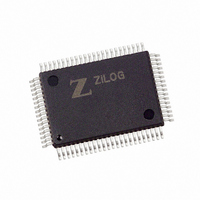Z16F2810FI20EG Zilog, Z16F2810FI20EG Datasheet - Page 239

Z16F2810FI20EG
Manufacturer Part Number
Z16F2810FI20EG
Description
IC ZNEO MCU FLASH 128K 80QFP
Manufacturer
Zilog
Series
Encore!® ZNEOr
Datasheet
1.Z16F2800100ZCOG.pdf
(388 pages)
Specifications of Z16F2810FI20EG
Core Processor
ZNEO
Core Size
16-Bit
Speed
20MHz
Connectivity
I²C, IrDA, LIN, SPI, UART/USART
Peripherals
Brown-out Detect/Reset, DMA, POR, PWM, WDT
Number Of I /o
60
Program Memory Size
128KB (128K x 8)
Program Memory Type
FLASH
Ram Size
4K x 8
Voltage - Supply (vcc/vdd)
2.7 V ~ 3.6 V
Data Converters
A/D 12x10b
Oscillator Type
Internal
Operating Temperature
-40°C ~ 105°C
Package / Case
80-BQFP
Data Bus Width
16 bit
Data Ram Size
4 B
Interface Type
ESPI, I2C, UART
Maximum Clock Frequency
20 MHz
Number Of Programmable I/os
60
Number Of Timers
4
Operating Supply Voltage
2.7 V to 3.6 V
Maximum Operating Temperature
+ 105 C
Mounting Style
SMD/SMT
Minimum Operating Temperature
- 40 C
On-chip Adc
10 bit, 12 Channel
For Use With
770-1003 - ISP 4PORT FOR ZILOG ZNEO MCU269-4537 - DEV KIT FOR Z16F ZNEO
Lead Free Status / RoHS Status
Lead free / RoHS Compliant
Eeprom Size
-
Lead Free Status / Rohs Status
Details
Available stocks
Company
Part Number
Manufacturer
Quantity
Price
- Current page: 239 of 388
- Download datasheet (22Mb)
PS022008-0810
DMA Control of I
6. Software responds to the interrupt by reading the I2CISTAT register, clearing the
7. The Master starts the data transfer by asserting SCL Low. Once the I
8. When the first bit of the first data byte is transferred, the I
9. Software responds to the transmit data interrupt by loading the next data byte into the
10. The I
11. The bus cycles through steps 7–10 until the last byte has been transferred. If software
12. Software responds to the NAK interrupt by clearing the
13. When the Master has completed the acknowledge cycle of the last transfer it asserts
14. The Slave I
15. Software responds to the Stop interrupt by reading the I2CISTAT register, clearing the
The DMA engine is configured to support transmit and receive DMA requests from the
I
in the I
error condition interrupts to be handled by software while data movement is handled by
the DMA engine.
The DMA interface on the I
master mode address byte transfer. The START, STOP, and NAK bits must be controlled
by software.
2
C Controller. The I
I2CISTAT register, which causes the Slave Address Match interrupt. The
= 1. The Slave mode I
bit. Software loads the initial data byte into the I2CDATA register and sets the
in the I2CCTL register.
data available to transmit the SCL is released and the Master proceeds to shift the first
data byte.
bit, which asserts the transmit data interrupt.
I2CDATA register.
Acknowledge (or Not Acknowledge for the last data byte).
has not yet loaded the next data byte when the Master brings SCL Low to transfer the
most significant data bit, the Slave I
register is written.
When the Slave receives a Not Acknowledge, the I
the I2CISTAT register and generates the NAK interrupt.
register and by asserting the
the STOP or RESTART condition on the bus.
I2CISTAT register).
SPRS
2
C Mode register and clearing the TXI bit in the I
2
bit.
C Master shifts in the remainder of the data byte. The Master transmits the
2
C Transactions
2
C Controller asserts the STOP/RESTART interrupt (set
2
C data interrupt requests must be disabled by setting the
2
P R E L I M I N A R Y
C Controller acknowledges on the bus.
2
C Controller is intended to support data transfer but not
FLUSH
2
bit of the I2CCTL register.
C Controller holds SCL Low until the data
2
C Controller sets the
2
C Control register. This allows
TXI
2
I
C controller sets the
2
C Master/Slave Controller
Product Specification
bit in the I2CCTL
ZNEO
2
SPRS
C Controller has
Z16F Series
NCKI
RD
DMAIF
bit in
bit is set
TXI
bit in
TDRE
SAM
bit
bit
223
Related parts for Z16F2810FI20EG
Image
Part Number
Description
Manufacturer
Datasheet
Request
R

Part Number:
Description:
Communication Controllers, ZILOG INTELLIGENT PERIPHERAL CONTROLLER (ZIP)
Manufacturer:
Zilog, Inc.
Datasheet:

Part Number:
Description:
KIT DEV FOR Z8 ENCORE 16K TO 64K
Manufacturer:
Zilog
Datasheet:

Part Number:
Description:
KIT DEV Z8 ENCORE XP 28-PIN
Manufacturer:
Zilog
Datasheet:

Part Number:
Description:
DEV KIT FOR Z8 ENCORE 8K/4K
Manufacturer:
Zilog
Datasheet:

Part Number:
Description:
KIT DEV Z8 ENCORE XP 28-PIN
Manufacturer:
Zilog
Datasheet:

Part Number:
Description:
DEV KIT FOR Z8 ENCORE 4K TO 8K
Manufacturer:
Zilog
Datasheet:

Part Number:
Description:
CMOS Z8 microcontroller. ROM 16 Kbytes, RAM 256 bytes, speed 16 MHz, 32 lines I/O, 3.0V to 5.5V
Manufacturer:
Zilog, Inc.
Datasheet:

Part Number:
Description:
Low-cost microcontroller. 512 bytes ROM, 61 bytes RAM, 8 MHz
Manufacturer:
Zilog, Inc.
Datasheet:

Part Number:
Description:
Z8 4K OTP Microcontroller
Manufacturer:
Zilog, Inc.
Datasheet:

Part Number:
Description:
CMOS SUPER8 ROMLESS MCU
Manufacturer:
Zilog, Inc.
Datasheet:

Part Number:
Description:
SL1866 CMOSZ8 OTP Microcontroller
Manufacturer:
Zilog, Inc.
Datasheet:

Part Number:
Description:
SL1866 CMOSZ8 OTP Microcontroller
Manufacturer:
Zilog, Inc.
Datasheet:

Part Number:
Description:
OTP (KB) = 1, RAM = 125, Speed = 12, I/O = 14, 8-bit Timers = 2, Comm Interfaces Other Features = Por, LV Protect, Voltage = 4.5-5.5V
Manufacturer:
Zilog, Inc.
Datasheet:

Part Number:
Description:
Manufacturer:
Zilog, Inc.
Datasheet:











